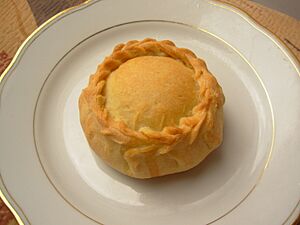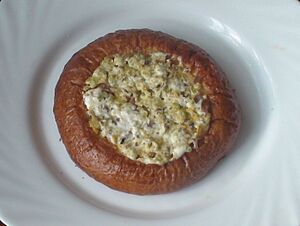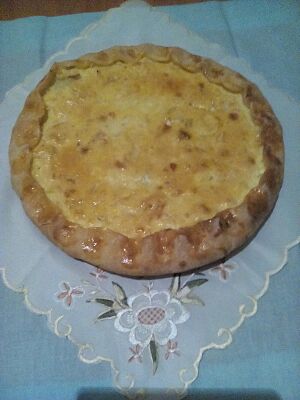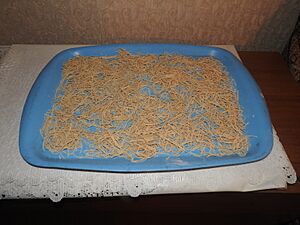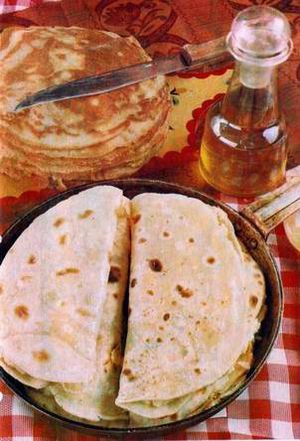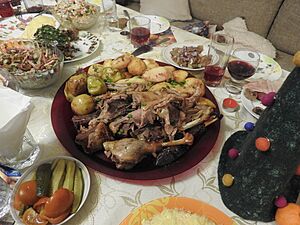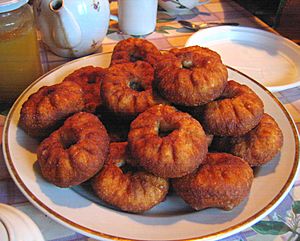Bashkir cuisine facts for kids
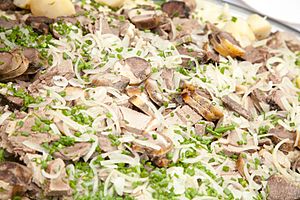
Bashkir cuisine is the traditional food of the Bashkirs, a group of people mainly from the Ural region. Their way of life, especially raising animals like cattle and horses, really shaped their food, culture, and traditions.
Contents
What Makes Bashkir Food Special?
Bashkir dishes don't use many spices. They mostly use just black and red pepper. A big part of Bashkir cooking is using lots of meat in almost every hot dish and snack.
Bashkirs especially love horse sausage called «kazy» and horse fat. They enjoy eating horsemeat with thick slices of fat. They often drink a sour broth called Korot (a fermented milk product) with it. This helps balance out the rich taste of the fat.
Food That Lasts Long
Because Bashkirs used to live a semi-nomadic life, moving around with their animals, they needed food that could last a long time. Many traditional Bashkir foods are boiled, dried, or cured. These include horse meat, lamb, dairy products, dried berries, dried grains, and honey.
Some examples of these long-lasting foods are:
- Kazy (horse sausage)
- Kaklangan it (jerky)
- Pastille (a fruit candy)
- Koumiss (a special drink)
- Seyale hary may (cherries in ghee, which is clarified butter)
- Muyyl mayi (bird cherry oil)
- Korot (dry kashk, a type of dried yogurt)
- Eremsek (cottage cheese)
- Ayran (doogh, a yogurt drink)
All these foods can be stored for a long time, even in summer. This makes them easy to take along when traveling. People believe that koumiss was often made while traveling. A container of mare's milk would be tied to a saddle and shaken all day long.
Bashkir Honey
Bashkir honey is very famous for its amazing taste. It is a source of great pride for the Bashkir people. You won't find a tea party without real Bashkir honey. A simple snack of fresh country sour cream with honey is a classic Bashkir treat. It's very important for Bashkirs to have real Bashkir honey, especially from the special Burzyan bees, often made by family members who are beekeepers.
Kumis: A Healing Drink
Koumiss is a national healing drink of the Bashkirs. Knowing how to make delicious koumiss has been a valued skill passed down through generations. Special horse breeds, like the Bashkir horse, are preferred for making koumiss. It's best to drink koumiss fresh because it quickly turns sour and loses its healing qualities. It has a small amount of alcohol in it.
Popular Bashkir Dishes
The traditional Bashkir dish called bishbarmak is made from boiled meat and salma. Salma is a type of thick, chopped noodle. It's usually topped with lots of herbs and onions and seasoned with korot. This is another unique thing about Bashkir cooking: dairy products like korot or sour cream are often served with main dishes. Most Bashkir dishes are easy to make and very filling.
Many dishes are considered national foods by people from the Ural Mountains to the Far East. These include ayran, buza (a drink made from wheat or oatmeal), kazy, katlama, kumis, manti, oyre (soup), and umas-ashy.
Modern Bashkir Food
Today, Bashkir dishes still keep their traditional flavors. But they also include new ingredients and ways of serving food. Even with many new and fancy dishes, traditional foods are still very important in Bashkir cooking and at special celebrations.
At a festive Bashkir meal, you will almost always find bishbarmak, kazy, hurpa (a clear soup), bukken, or chak-chak.
The Bashkir Tea Party
The Bashkirs have a common saying: «drink tea.» This phrase means an invitation to a full Bashkir tea party! It includes pies, yuyasa, boiled meat, sausage, cheesecake, sour cream, jam, honey, and anything else the host has. «Drinking tea» for Bashkirs is like having a big snack. It's often enough to replace breakfast or lunch.
Bashkirs always drink tea with milk. Guests are not even asked if they want milk; it's just added. This tradition is so old that in some areas, people even debate whether to add milk before or after pouring the tea!
Festive Meals
For holidays, Bashkirs prepare special dishes. These include Bishbarmak, Chak-Chak, Belish, and Gubadia. Chak-chak is a must-have at any festive table.
At a festive meal, it's common to offer each guest an ulush. This is a special portion of meat from a ram or goose. Bashkirs have many festive dishes made for specific events:
- Keyeu-bilmene (Pelmeni): These are small dumplings made for a wedding, especially for the groom.
- Keelen-tukmasy (noodle): These are special noodles that the bride makes to show how skilled she is. These noodles should be extra thin and light.
The chak-chak made by the bride is an important part of the wedding ceremony. After the wedding, the bride washes her hands and offers a piece of chak-chak to all the guests.
Kaz-oemahe is a special event where the hostess invites neighbors to help prepare geese. In the evening, after the work is done, the hostess treats everyone to fresh goose meat.
Foods Not Eaten
Some foods are not eaten due to religious traditions. These include pork, meat from animals that eat other animals (like falcons or hoopoes), and meat from snakes or frogs. It was also not allowed to eat swans or cranes, as these birds are important symbols for the Bashkirs.
Also, certain parts of animals were not eaten, such as thyroid glands, spinal cord, and spleen. For fish, it was not common to eat fish that do not have scales.
Table Manners
Traditional Bashkir table manners include these rules:
- Serve food right away when guests arrive.
- There should be an odd number of flatbreads on the table, but always more than the number of guests.
- The host should be the first to touch the food.
- The oldest guest is served first.
- The host stops eating as soon as the guest stops eating.
- If there isn't enough food and a guest is still hungry, the host should eat as little as possible to make sure the guest gets enough.
- Always take food and drinks only with your right hand.
- Do not cut fresh bread with a knife, and do not bite off a whole flatbread.
- You should take the less desirable food from a shared dish, leaving the best for others.
- During the meal, be friendly with the host and seem happy.
- At the end of the meal, say a prayer for the host's well-being.
Images for kids
See also
 In Spanish: Gastronomía de Baskortostán para niños
In Spanish: Gastronomía de Baskortostán para niños


